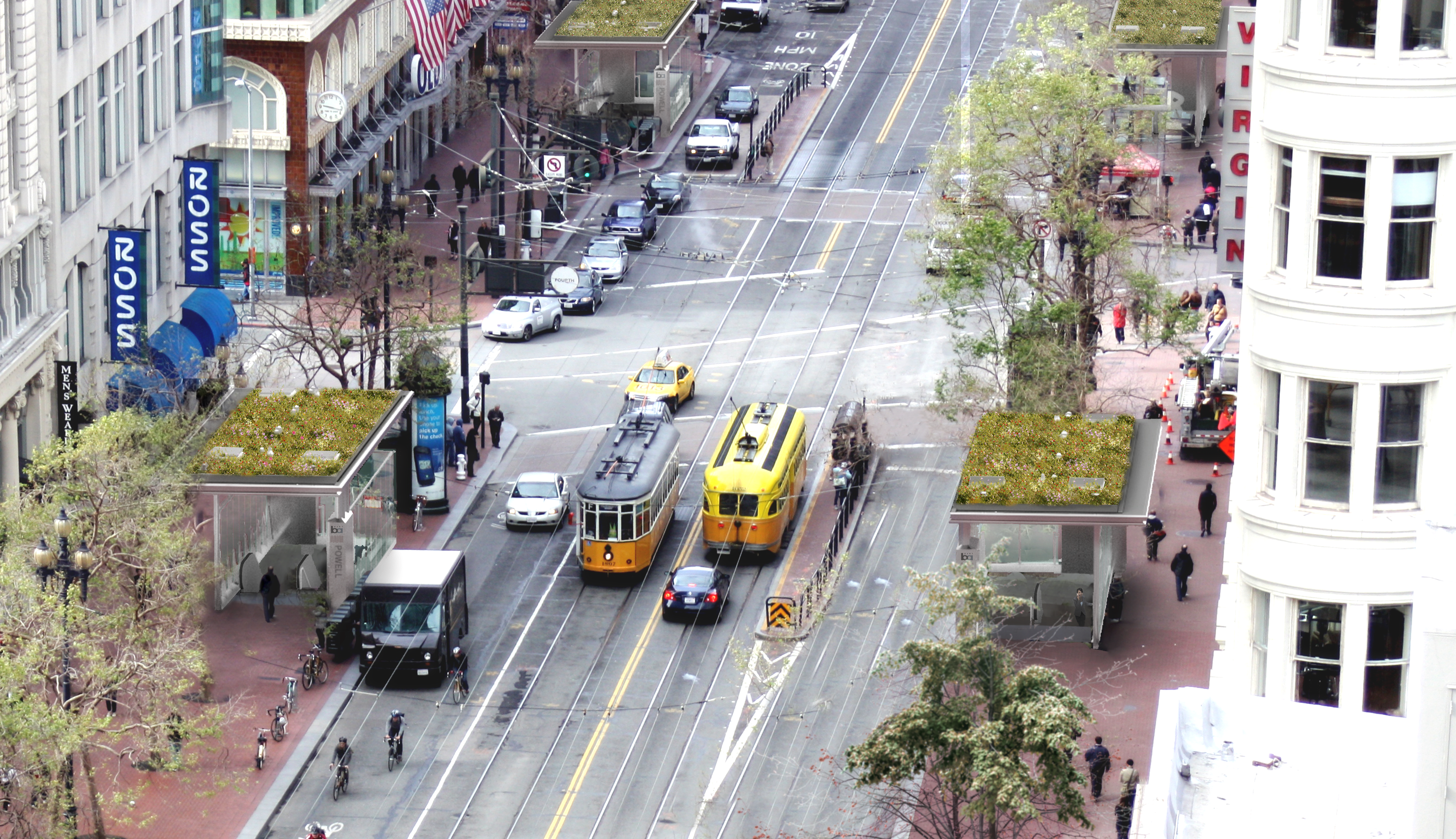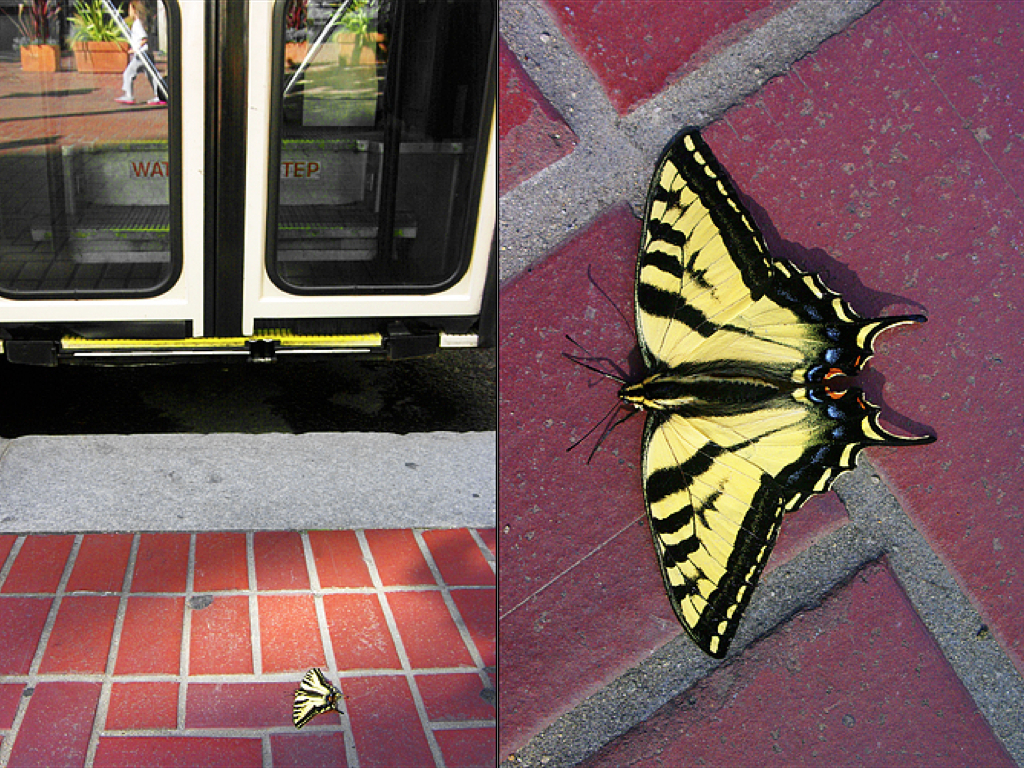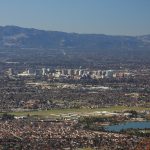
Plans to create living roofs atop canopy structures protecting Bay Area Rapid Transit (BART) station entrances in San Francisco are underway as part of a pilot program.
BART has partnered with the environmental nonprofit Nature in the City to create the living roofs on 20-foot-tall canopies measuring 30 feet by 60 feet at the Montgomery and Powell Street stations. The elevated habitat, visible to people in buildings two stories and higher, will support the western tiger swallowtail butterfly and other wildlife hurt by urban development.
Living roofs, cropping up in dozens of San Francisco locations, are an example of a sustainable design approach to transform underused roof space for environmental benefits.
In the case of the BART station entrances, the roofs also result from the public appeals process to mitigate a larger tree removal issue on Market Street due to canopy construction.
At the root of the matter is the London plane tree. It’s a hybrid of American sycamore and Oriental plane. Many line Market Street where BART is installing new escalators at Embarcadero, Montgomery Street, Powell Street, and Civic Center stations. The installations are part of the $96.5 million Market Street Escalators Renovation Project approved in 2019 and funded by Measure RR. It’s the largest escalator renovation contract in BART’s 50-year history.

Living roof canopies installed above entrances to Powell St Station.
The investment, expected to improve escalator reliability and safety, coincides with the Market Street Canopy Project to build 22 canopies over escalators at station entrances. The canopies have high glass walls and a motorized gate to lock station entrances during non-business hours — features that modernize hubs and shield escalators from inclement weather, debris, and other destructive elements. Each canopy also has a real-time train arrival digital display.
Two of the canopies — one at Powell Street Station at Ellis and Market streets and the other at Civic Center Station near Seventh and Market streets — were completed in 2018. To install more, BART submitted applications in 2020 to the San Francisco Public Works Department to remove 50 London plane trees that presented barriers to construction. Environmental review and other documents showed no significant impact and plans to remove nearly three dozen trees were approved.
 Seeking Alternatives
Seeking Alternatives
However, tree and nature advocates contested the removal. They were concerned about the environmental damage of removing trees from San Francisco’s already small tree population. Advocates said some trees on the chopping block were in good health.
“I’ve objected to a lot of proposed tree removals but the ones that get to me the most are the ones in which it was pretty clear there was no consideration for alternatives,” said Joshua Klipp, one of several residents who filed an appeal with the City & County of San Francisco Board of Appeals of a July 30, 2021 issuance of a public works order to remove 32 trees from various Market Street locations.
Advocates also reminded city officials about trees’ role in combating climate change and providing habitat. London plane trees are one of 10 species upon which the western tiger swallowtail butterfly will lay her eggs, said Amber Hasselbring, executive director of Nature in the City, which advocates for butterflies as part of the Tigers on Market Street conservation project.
“A river canyon ecosystem is their natural habitat, so Market Street looks like a river canyon to them with trees lining both sides,” she said.
Ultimately, the appeals process and negotiations with tree advocates and the San Francisco Bureau of Urban Forestry contributed to an agreement that reduced the number of trees removed. It requires BART to pay fees for any trees cut down and put that toward tree replacement.

Tigers on Market Street.
Going Green
BART also agreed to help develop the living roof idea it had previously considered. Mark Dana, BART project manager, said BART’s original, conceptual canopy design included the possibility for “living or green” roof garden areas.
In fact, the first two canopies constructed in 2018 have structural design and irrigation features to support living roofs. But Dana said BART didn’t cultivate plans for installation in the contract because officials were concerned about the gardens’ maintenance if installed. So when the board of directors approved a contract in 2020 to construct more canopies, there was no immediate plan for living roofs.
 That changed after tree removal mitigation measures were agreed upon in early 2022 and BART aligned with Nature in the City. The nonprofit group will design and develop a plan for the living roof habitats and, when approvals and pricing is finalized, coordinate a pilot project to install living roofs on the two canopies covering the one entrance at each of the Montgomery and Powell Street stations.
That changed after tree removal mitigation measures were agreed upon in early 2022 and BART aligned with Nature in the City. The nonprofit group will design and develop a plan for the living roof habitats and, when approvals and pricing is finalized, coordinate a pilot project to install living roofs on the two canopies covering the one entrance at each of the Montgomery and Powell Street stations.
Hasselbring said Nature in the City would likely choose a selection of nectar-producing plants and perennial grasses for the living roofs due to low maintenance and irrigation. She said planting could commence by late January, but timing depends on approvals and agreements Nature in the City must secure with various city agencies.
“This is a big butterfly, and so it needs a bigger flower to land on and a deep nectar tube to put its proboscis in,” Hasselbring said. “So we’re considering that when looking at plants that would grow on roofs.”
Nature in the City also plans to launch a corporate sponsorship campaign in January to raise funding to pay for living roof maintenance and possibly more installations. In the future, it would like to install cameras to show live garden video and images of the butterflies flying to nectar stops.
In the meantime, because the western tiger swallowtail is the “largest butterfly we have in San Francisco,” they are easy to spot above the treetops, Hasselbring added. “Sue Bierman Park and Yerba Buena Park are great places nearby Market Street to see [them].”
Construction also is currently visible at four BART station entrances downtown where a total of 41 escalators will be replaced once the project is completed. The living roofs will be installed at Powell Street Station near Fifth and Market Streets and at Montgomery Street Station at New Montgomery and Market streets.
Top Photo: Collage of Market Street and the tiger swallowtail. All photos by Nature in the City.

